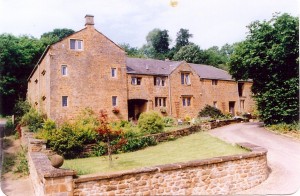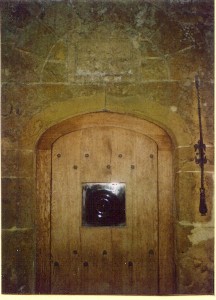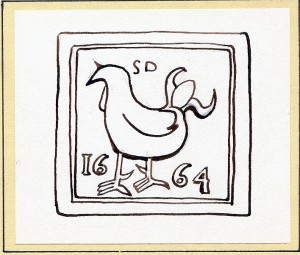Springfield House
The house now known as Springfield House has a long and interesting history. For centuries it was owned by the DAVIS family and their descendants, the BURROWES and the KNIGHTS.
The Davis family were established here at the time of the dissolution of religious houses, when Warmington came into lay hands. From wills and property deeds, it is possible to trace the descent of the Davis family from that time. Substantial families, such as the Davises, tended to name their sons in a distinctive way – first son after paternal grandfather, second son after father. In the Davises’ case, this gives a pattern in the main line of Simon Davis, his first son Richard, his first son Simon and his first son Richard.
Doorway of Springfield House, fronting School Lane showing datestone.
The date stone over the door at Springfield House is a marriage stone, thought to mark the marriage of a Simon Davis and Margerie or Mary Draper, 1538. (Another marriage stone is believed to be at The Dene, SDFP 1686, recording the marriage of a Simon Davis, of a junior branch, and Frances Perkins. The marriage is in the parish register.) After a few generations it is usual for the main line to fail through lack of a male heir. This happened to the Davises. The Simon Davis, whose initials with the date 1664 appear on the cock sign on the barn at Springfield House, had no sons.
The Fighting Cock
His only daughter, Alice, married twice. In his old age Simon settled Springfield House and its land upon John Burrowes, Alice’s only son by her first marriage. The manorial rights, bought by Simon’s father Richard Davis, together with the manor house and its land, went to one of the sons of Alice’s second marriage, a young man called Richard Davis Knight.
Simon made one proviso: if the Burrowes line failed, the Springfield property was to pass to the Knights. John Burrowes, grandson of the one mentioned above, died in 1755 leaving his property to his distant half-cousin John Knight, a haberdasher of London. After a further generation in Knight ownership, the house and its land finally passed away from the family in the 1820s.
At many periods the house and its land were occupied by tenants. Throughout the seventeenth century it was used both as a farmhouse and hostelry, going ‘by the sign of the Cock’ (1677). Known innkeepers were Henry Thomas (died 1626), John Thomas (died 1634) and John Tue (died 1691). In the later eighteenth and nineteenth centuries, four generations of the Wady family farmed there until the death of Thomas Owen Wady in 1907.
Later owners
William Ledbrook, a member of a long-established farming family in Burton Dassett and neighbouring parishes, bought the farm in the 1820s. From the Ledbrooks the farm passed to Edward Bolton King of Chadshunt. He died in 1876, leaving all his property to his widow Louisa for her life and then to their only child, Bolton King, a man of great and diverse abilities. He was a brilliant scholar, undertook experimental schemes in Warwickshire to alleviate rural poverty, wrote a history on Italian unity and served for 24 years as the first Director of Education for Warwickshire.
He and his mother acting jointly sold the property in 1914 to Alfred (Fred) Seage of Arlescote. Fred Seage owned the property for nearly 50 years, although he was retired and living in Banbury in 1963 when he sold it to Owen Hall. Three houses were built in the orchard, and a new farmhouse built towards the Arlescote end of the farmland. The house was bought by Marian Handscombe in 1965.



